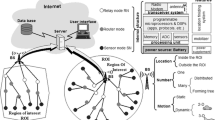Abstract
The vast literature on the wireless sensor research community contains many valuable proposals for managing energy consumption, the most important factor that determines sensors’ lifetime. Interesting researches have been facing this requirement by focusing on the extension of the entire network lifetime: either by switching between node states (active, sleep) or by using energy-efficient routing. We argue that a better extension of the network lifetime can be obtained if an efficient combination of management mechanisms can be performed at the energy of each single sensor and at the load distribution over the network. Considering these two accuracy levels (i.e., node and network), this paper presents a new approach that uses cost functions to choose energy-efficient routes. In particular, by making different energy considerations at a node level, our approach distributes routing load, avoiding, thus, energy-compromised hotspots that may cause network disconnections. The proposed cost functions have completely decentralized and adaptive behavior and take into consideration the end-to-end energy consumption, the remaining energy of nodes, and the number of transmissions a node can make before its energy depletion. Our simulation results show that, though slightly increasing path lengths from sensor to sink nodes, some proposed cost functions (1) improve significantly the network lifetime for different neighborhood density degrees, while (2) preserving network connectivity for a longer period of time.














Similar content being viewed by others
Notes
We believe that, even if these issues may cause longer convergence time, they will not affect the correct execution of the proposed algorithms. A detailed study of their impact on our approaches constitutes a future work.
References
Kwon S, Shroff NB (2006) Energy-efficient interference-based routing for multi-hop wireless networks. In: IEEE INFOCOM, Barcelona, 28–29 April 2006
Ingelrest F, Simplot-Ryl D, Stojmenovic I (2006) Optimal transmission radius for energy efficient broadcasting protocols in Ad Hoc networks. IEEE Trans Parallel Distrib Syst 17:536–547
Shah RC, Rabaey JM (2002) Energy aware routing for low energy ad hoc sensor networks. In: Proceedings of IEEE wireless communications and networking conference (WCNC), vol 1. IEEE, Piscataway, pp 17–21
Hassanein H, Luo J (2006) Reliable energy aware routing in wireless sensor networks. In: Second IEEE workshop on dependability and security in sensor networks and systems DSSNS, Columbia, 24–28 April 2006
Carle J, Simplot-Ryl D (2004) Energy-efficient area monitoring for sensor networks. Computer 37:40–46
Rodoplu V, Meng TH (1999) Minimum energy mobile wireless networks. IEEE J Sel Areas Commun 17:1333–1344
Cardei M, Wu J, Yang S (2004) Topology control in Ad hoc wireless networks with Hitch-hiking. In: The First IEEE international conference on sensor and ad hoc communications and networks (SECON04), Santa Clara, October 2004
Cardei M, Du D (2005) Improving wireless sensor network lifetime through power aware organization. ACM J Wirel Netw 11:333–340
Kalpakis K, Dasgupta K, Namjoshi P (2002) Maximum lifetime data gathering and aggregation in wireless sensor networks. University of Maryland Baltimore County, Baltimore
Tang X, Xu J (2006) Extending network lifetime for precision-constrained data aggregation in wireless sensor networks. In: Proceedings of IEEE INFOCOM, Barcelona, 23–29 April 2006
Chang J, Tassiulas L (2000) Energy conserving routing in wireless ad-hoc nertworks. In: IEEE INFOCOM, Tel-Aviv, 26–30 March 2000
Shresta N (2006) Reception awarness for energy conservation in Ad Hoc networks. Ph.D., Macquarie University Sydney
Agarwal S, Krishnamurthy S, Katz R, Dao S (2001) Distributed power control in ad-hoc wireless networks. In: Proceedings of PIMRC, San Diego, September 2001
Zhang B, Mouftah HT (2006) Energy-aware on-demand routing protocols for wireless ad hoc networks. Wirel Netw 12:481–494
Chen B, Jamieson K, Balakrishnan H, Morris R (2002) Span: an energy-efficient coordination algorithm for topology maintenance in ad hoc wireless networs. Wirel Netw 8(5):481–494
Xu Y, Heidemann J, Estrin D (2001) Geography-informed energy conservation for ad hoc routing. In: Proceedings of the 7th annual international conference on mobile computing and networking, Rome, July 2001
Mirza D, Owrang M, Shrugers C (2005) Energy-efficient wakeup scheduling for maximizing lifetime of IEEE 802.15.4 networks. In: International conference on wireless internet (WICON’05), Budapest, June 2005
Le Merrer E, Gramoli V, Viana AC, Bertier M, Kermarre A-M (2006) Energy aware self-organizing density management in wireless sensor networks. In: ACM MobiShare, Los Angeles, 23–29 September 2006
Culler D, Estrin D, Srivastava M (2004) Overview of sensor networks. IEEE Computer Society, Los Alamitos, pp 41–49
The Network Simulator (2008) ns2 simulator. http://www.isi.edu/nsnam/ns/
Sengul C, Kravets R (2005) Conserving energy with on-demand topology management. In: Proceedings of the IEEE international conference on mobile adhoc and sensor systems, Washington, DC, 7–10 November 2005
Sengul C, Kravets R (2005) TITAN: on-demand topology management in ad hoc networks. Mobile Comput Commun Rev 9:77–82
Johnson D, Maltz D, Broch J (2001) DSR: the dynamic source routing protocol for multihop wireless Ad Hoc networks. In: Perkins CE (ed) Ad hoc networking. Addison-Wesley, Los Angeles, pp 139–172
Perkins C, Belding-Royer E, Das S (2003) Ad hoc on-demand distance vector (AODV) routing. The Internet Society, Washington, DC
Gupta P, Kumar P (1998) Critical power for asymptotic connectivity in wireless networks. In: McEneany WM, Yin G, Zhang Q (eds) Stochastic analysis, control, optimization and applications: a volume in honor of W.H. Fleming. Birkhauser, Boston, pp 547–566
Heinzelman WR, Chandrakasan A, Balakrishnan H (2000) Energy-efficient communication protocol for wireless microsensor networks. In: Proceedings of the 33rd Annual Hawaii international conference on system sciences (HICSS), Maui, 4–7 January 2000
Author information
Authors and Affiliations
Corresponding author
Additional information
This research was financed by the ANR-OCARI project.
Rights and permissions
About this article
Cite this article
Rahmé, J., Carneiro Viana, A. & Al Agha, K. Looking for network functionalities’ extension by avoiding energy-compromised hotspots in wireless sensor networks. Ann. Telecommun. 63, 487–500 (2008). https://doi.org/10.1007/s12243-008-0043-4
Received:
Accepted:
Published:
Issue Date:
DOI: https://doi.org/10.1007/s12243-008-0043-4




